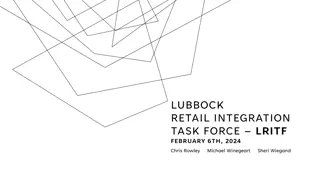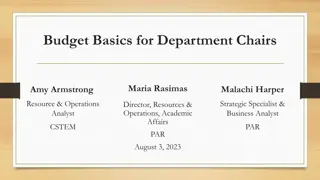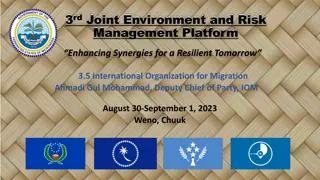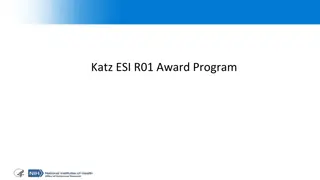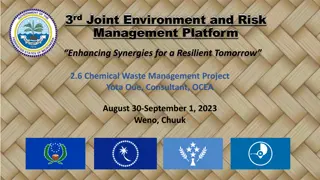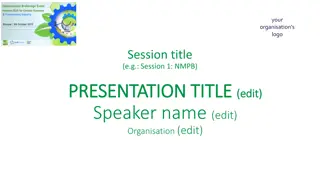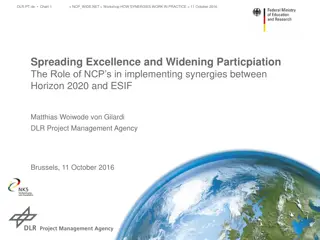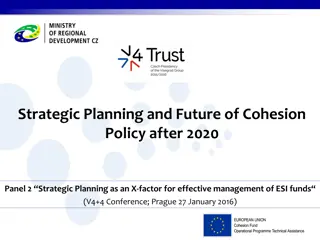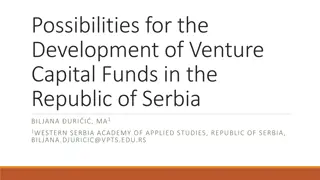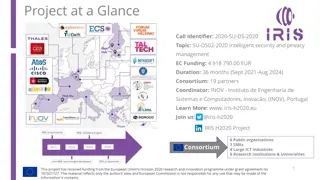Synergies between ESI Funds and H2020 in Practice
Analyzing real-world synergies between ESI Funds and H2020 to understand their practical implications. Insights shared by Prof. Rafael Rodríguez-Clemente from IDAEA-CSIC in Barcelona.
Download Presentation

Please find below an Image/Link to download the presentation.
The content on the website is provided AS IS for your information and personal use only. It may not be sold, licensed, or shared on other websites without obtaining consent from the author.If you encounter any issues during the download, it is possible that the publisher has removed the file from their server.
You are allowed to download the files provided on this website for personal or commercial use, subject to the condition that they are used lawfully. All files are the property of their respective owners.
The content on the website is provided AS IS for your information and personal use only. It may not be sold, licensed, or shared on other websites without obtaining consent from the author.
E N D
Presentation Transcript
NCP_WIDE.NET Project: Synergies between ESI Funds and H2020. Understanding how the Synergies work in practice Prof. Rafael Rodr guez-Clemente. IDAEA-CSIC. Barcelona. SPAIN. raro@orgc.csic.es Brussels (Belgium) 11 to 12 October 2016.
The idea is that regional authorities can exploit the smart specialization logic by undertaking a rigorous self-assessment of a region s knowledge assets, capabilities and competences and the key players between whom knowledge is transferred McCann and Ortega-Argil s (2011) Smart Specialisation, Regional Growth and Applications to EU Cohesion Policy. Economic Geography Working Paper 2011 : Faculty Of Spatial Sciences, University Of Groningen, p.3 [URL: http://ipts.jrc.ec.europa.eu/docs/s3_mccann_ortega.pdf].
Billion EUR Less developed regions 182.2 Transition regions 35.4 More developed regions 54,4 Cohesion Fund 63.4 European territorial cooperation 10.1 Of which Cross border cooperation 7.5 Transnational cooperation 2.0 Interregional cooperation 0.6 Outermost regions and northern sparsely populated regions 1.6 Youth Employment initiative 3.2 TOTAL * * This figure does not include EUR 1.5b of Urban Innov. Actions and EC technical assistance 350.3* 3
Regional Innovation Scoreboard 2012
From and From: : Commercialisation and Strategies Commercialisation of Strategies. OECD Publishing 2013 of Public Public Research Research: New : New Trends Trends . OECD Publishing 2013
*Research and Technology Specialisation . *Lincoln Business School, University of Lincoln, UK. **European Commission, JRC-IPTS, Seville (Spain) S3 Policy Brief Series n 15/2015 October 2015. S3 Platform, JRC-IPTS Research and Technology Organisations Specialisation . . David Charles,* and Katerina Ciampi Stancova** Organisations and Smart and Smart
*Research and Technology Specialisation . *Lincoln Business School, University of Lincoln, UK. **European Commission, JRC-IPTS, Seville (Spain) S3 Policy Brief Series n 15/2015 October 2015. S3 Platform, JRC-IPTS Research and Technology Organisations Specialisation . . David Charles,* and Katerina Ciampi Stancova** Organisations and Smart and Smart
CSIC is the main public research institution in Spain. It is formed by more than 122 centers and institutes spread across all the Autonomous Regions of Spain, with a staff of more than 10.000, of whom more than 3.500 are staff researchers and more than other 2.700 scientists have different kinds of contractual forms with the Institution. CSIC has 6% of all the staff dedicated to Research and Development in Spain but generates approximately 20% of all scientific production in the country and is the main producers of national patents. In the last 10 years, CSIC has signed more than 15.000 research contracts or other services with Spanish companies and created 85 spin-offs. CSIC participated in 723 projects financed by FP7, and up to present CSIC is participating in more than 200 projects of H2020.
Possible roles for the RTO: a) identify industry needs and opportunities; * b) use their international networks to facilitate access to global knowledge by the SMEs; * c) support the establishment and development of thematic clusters. * d) offer sophisticated infrastructures and equipment of the RTO to facilitate the access of the SMEs to the Key Enabling Technologies (KET) e) the RTO as problem or challenge solving oriented interdisciplinary institutions *Research and Technology Stancova** . *Lincoln Business School, University of Lincoln, UK. **European Commission, JRC-IPTS, Seville (Spain) S3 Policy Brief Series n 15/2015 October 2015. S3 Platform, JRC-IPTS Research and Technology Organisations Organisations and Smart and Smart Specialisation Specialisation . . David Charles,* and Katerina Ciampi
- Only a small share of KETs are also fast growing technologies, although the degree of overlapping between KETs and FGTs varies substantially across different KETs fields. - While KETs are concentrated in Central Europe, FGTs prevail in Scandinavian countries and the UK. - While there is evidence of some regional convergence in KETs and, to a less extent, in FGTs, spatial correlation increases over time, showing that diffusion often occurs across contiguous regions. - The results of the estimations of the effects of FGTs and KETs on innovation (patents) and economic (GDP per capita) growth show that only specialisation in KETs directly affects economic growth, while specialisation in FGTs has an impact on growth only indirectly, that is through its impact on regions innovation performances. - Overall, these results confirm the pervasive and enabling role of KETs pointing to the importance for European regions to target these technologies as part of their RIS3 strategies. Evangelista R., Meliciani V. and Vezzani A. (2015). The Specialisation of EU Regions in Fast Growing and Key Enabling Technologies. JRC Technical Report, EUR 27524 EN; doi:10.2791/844794.
Governance and management structures of the RIS3 and the ERDF Operational Programs (OP) in general and with a few exceptions, adopted a conservative attitude trying to rely on their own previous experience of management with little, if any, participation of the academia, industry and other social actors. The participation of private companies in the RIS3 elaboration was not very significant, partly due to the lack of criteria for their selection in this highly political issue. The political changes happened in Spain after the Regional Elections of May 2015, produced a revision of the RIS3 strategies of several Autonomous Communities (AC), which increases the delays in the implementation of the OP. Consensus about RIS3 is a must for its success!
The complexity of the procedure in the management of the research and innovation calls based in FEDER managerial standards provokes the dismissal of possible participants to this process of public support to innovation of the economic system. A centralized institution such as CSIC may have some problems adapting itself to the specific procedures of some Autonomous Regions The Calls to implement RIS3 have been an adaptation of previous instruments such as the Autonomous Research Programs to the priorities defined in the RIS3. In other cases, new instruments have been defined taking into account sectorial as well as territorial criteria for the selection of projects, other actions and the management structures.
May be one of the most important hurdle for the implementation of the RIS3 and the participation of a large RTO is the fractioning of responsibilities among administration along the lines of their competences, i.e. Depts. of Agriculture, Industry, Higher Education and Research, etc., which sometimes produces differences in the rules applied to the engagement of stakeholders for their participation in proposals or other actions. An important observed obstacle for the participation of Large Research Organization is the concern expressed by some local institutions depending of the local governments that consider the RIS3 as an instrument for their own deployment and functioning A general obstacle detected in some regions is the absence of a cooperation tradition between the knowledge and the productive systems, particularly SMEs, including the institutions managed by the regional authorities such as the Universities These drawbacks also affects the efforts to promote interregional cooperation or the internationalization of the innovation products and services promoted by the RIS3, where the RTO could be clear actors through its networks. - - - -
Be aware and committed with the demands and priorities of the Regions research and innovation programs, besides the National and European Research Programs and procedures Address the connectivity problem with SMEs, as this absence of communication and acknowledgement difficult the awareness of the companies of the advantages of applying the KETs to their productive culture Affiliate to the Thematic Clusters promoted by the Regional Governments Propose the use of its own networks to facilitate the internationalization of regional SMEs and other innovation actors.
Open consultation Transparent monitoring and evaluation SEEKING CLEAR ECONOMIC AND SOCIAL OUTPUTS AND OUTCOMES Minimizing burocratic barriers. Adapt management time to business Codesign and committment Adapted from Regional Innovation Monitor Plus. Thematic Paper 1. 2 May 2014
Cope with the reluctance to move from the business as usual model to the challenging model of openness, participation, search for performance and internationalization of the RIS3 Use the RTO as a regional level to transfer new technologies such as the KET to the industrial sectors More effort must be done to unify the criteria of management, allocation of resources and simplification of procedures to handle the calls throughout all the regional priorities and actions It is evident that the degree of success of the RIS3 and PO applied at regional level are strongly related to the mode of governance. A regional centralized authority of management instead of a fractioned topical management could better favor synergetic interactions between different but complementary production sectors between themselves and also with the academia. More regional competitiveness and the development of regional niches of excellence can be derived from this open model of governance. The political entities hosting RTO should better coordinate with the Regions to support their effort in implementing the RIS3.
Thank you for your attention! raro@orgc.csic.es











